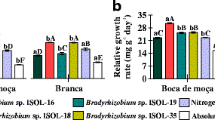Abstract
The effects of young plants of different legume species on the rate of multiplication of Halotydeus destructor (Tucker)(Acarina: Penthaleidae) were examined in one, two or four week experiments in the laboratory. Rates of multiplication of H. destructor were substantially greater on Vicia sativa (common vetch), Phaseolus vulgaris (dwarf bean) and Pisum sativum (snow pea), than on subterranean clover, Trifolium subterraneum; cultivars Dalkeith, Geraldton and Junee. Levels of soluble carbohydrate and soluble nitrogen were greater in vetch, bean and pea, than in the subclovers. Concentrations of 20 amino acids were not associated with differences in mite performance; pea contained higher levels of glutamine and homoserine than the other plants, which may have adversely affected mite multiplication.
In further experiments a carbohydrate supplement caused a fourfold increase in rate of multiplication on subclover cv Junee, but had no effect on rate of multiplication on vetch cv Blanchefleur. The carbohydrate supplement did not cause the rate of multiplication on subclover to equal that on vetch. Subclover is not an optimum host plant for H. destructor nutritionally. The nutritional value of host plants is one factor affecting mite multiplication.
Similar content being viewed by others
References
Anon, 1977. Individual/simultaneous determination of nitrogen and/or phosphorus in BD acid digests. Technicon Industrial System. Industrial Method No. 334.
Breukel, L.M. and Post, A., 1959. The influence of manurial treatment of orchards on the population density of Metatetranychus ulmi (Koch) (Acari: Tetranychidae). Entomol. exp. appl. 2: 38–47.
Dabrowski, Z.T., Studies on the relationships of Tetranychus urticae Koch and host plants. III. Gustatory effect of some amino acids. Polskie Pismo ent. 43: 309–330.
Dabrowski, Z. T. and Bielak, B., 1978. Effect of some chemical compounds on the behaviour and reproduction of spider mites (Acarina: Tetranychidae). Entomol. exp. appl. 24: 117–126.
Faichney, G. J. and White, G. A., 1938. Methods for the analysis of feeds eaten by ruminants. Commonwealth Scientific and Research Organisation, Australia. pp. 12–14.
Gerson, U. and Aronowitz, A. 1980. Feeding of the carmine spider mite on seven host plant species. Entomol. exp. appl. 28: 109–115.
Henneberry, T.J. 1962. The effect of plant nutrition on the fecundity of two strains of two-spotted spider mite. J. econ. Entomol. 55: 134–137.
Jeppson, L.R., Keifer, H.H. and Baker, E.W. 1975. Mites injurious to economic plants. University of California Press, Berkeley. 614pp + plates 1–74.
Morris, O.N. 1961. The development of clover mite, Bryobia praetiosa (Acarina, Tetranychidae) in relation to the nitrogen, phosphorus, and potassium nutrition of its host plants. Annls. entomol. Soc. Amer. 54: 551–556.
Norris, K.R. 1938. A population study of the red-legged earth mite (Halotydeus destructor) in Western Australia, with notes on associated mites and Collembola. C.S.I.R. Pamphlet No. 84: 1–23.
Pate, J.S. 1977. Nodulation and nitrogen metabolism. In Sutcliffe, J.F. and Pate, J.S. editors. The physiology of the garden pea. pp349–383. Academic Press.
Ridsdill-Smith, T.J., 1991a. Biology and ecology of redlegged earth mite, blue oat mite and lucerne flea. Plant Protection Quart. 6: 159–161.
Ridsdill-Smith, T.J. 1991b. Laboratory rearing of Halotydeus destructor (Tucker) (Acari: Penthaleidae). Jour. Aust. ent. Soc. 30: 313.
Rodriguez, J.G. and Rodriguez, L.D., 1987. Nutritional ecology of phytophagous mites. In Slansky, F. Jr. and Rodriguez, J.G. editors. Nutritional Ecology of Insects, Mites, Spiders and Related Invertebrates. pp 177–208. John Wiley and Sons, New York.
Storms, J.J.H. and Noordink, J. Ph. W., 1972. Nutritional requirements of the two spotted spider mite, Tetranychus urticae Koch (Acarina, Tetranychidae). Zesz. Probl. Post. Nauk Roln. 129: 59–67.
Swan, D.C. 1934. The red-legged earth mite Halotydeus destructor (Tucker) in South Australia: with remarks upon Penthaleus major (Duges). Jour. Agric. South Aust. 38: 353–367.
van der Geest, L.P.S., Bosse, Th. C. and Veerman, A. 1983. Development of a meridic diet for the two-spotted spider mite Tetranychus urticae. Entomol. exp. appl. 33: 297–302.
van de Vrie, M., McMurtry, J.A. and Huffaker, C.B. 1972. III. Biology, ecology, and pest status, and host-plant relations in tetranychids. Hilgardia 41: 343–432.
Author information
Authors and Affiliations
Rights and permissions
About this article
Cite this article
Annells, A.J., Ridsdill-Smith, T.J. Host plant species and carbohydrate supplements affecting rate of multiplication of redlegged earth mite. Exp Appl Acarol 18, 521–530 (1994). https://doi.org/10.1007/BF00058935
Accepted:
Issue Date:
DOI: https://doi.org/10.1007/BF00058935




